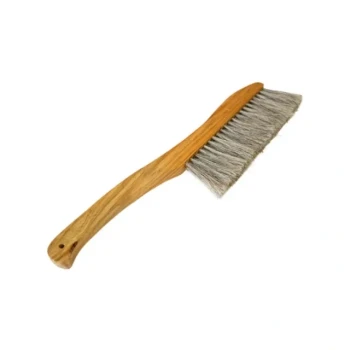In short, plastic and polystyrene hives offer superior insulation, durability, and lower maintenance compared to traditional wood. These modern materials are engineered to be lightweight and long-lasting, requiring minimal assembly and no painting. Their key advantage lies in exceptional thermal regulation, which helps bee colonies thrive in extreme weather, potentially leading to increased honey production and better overall health.
While wooden hives have a long and respected history, modern materials like plastic and polystyrene are designed to solve specific operational challenges for the beekeeper, focusing on colony health, ease of use, and long-term durability.

Superior Thermal Performance for Healthier Bees
One of the most significant advantages of plastic and high-density polystyrene hives is their ability to insulate the colony far more effectively than wood. This stable internal environment has a direct impact on bee health and productivity.
Drastic Reduction in Temperature Stress
Polystyrene (EPS) in particular offers exceptional thermal performance, providing up to eight times the insulation value of wood.
This means bees expend far less energy and consume fewer honey stores to maintain the critical brood nest temperature of 95°F (35°C). The colony is better protected from brutal winter cold and extreme summer heat waves.
Potential for Increased Honey Production
Because the bees use less energy to thermoregulate the hive, they can allocate more resources to other tasks.
This energy conservation often translates directly into more foraging activity and, consequently, a larger surplus honey crop for the beekeeper.
Unmatched Durability and Low Maintenance
Plastic and polystyrene hives are designed to reduce the beekeeper's workload and withstand years of use with minimal upkeep. This shifts the focus from equipment repair to colony management.
Built to Last
Unlike wood, which is susceptible to rot, warping, and cracking, these synthetic materials are highly durable and resist environmental damage. They do not require the periodic painting or chemical treatments that wooden hives need to prolong their life.
Impervious to Pests and Mold
Plastic and polystyrene are non-porous and do not absorb moisture, making them resistant to mold and mildew. Furthermore, they are impervious to destructive pests like wax moths, which can burrow into and damage wooden components.
Lightweight and Easy to Handle
Both materials are significantly lighter than wood, a crucial benefit for any beekeeper. Lifting hive bodies for inspections, moving entire colonies, and harvesting honey becomes a much less strenuous task, reducing physical strain.
Understanding the Trade-offs
While the advantages are compelling, it is essential to consider the complete picture when choosing a hive material. No option is perfect for every situation.
Moisture Management
The same high-insulation properties that keep bees warm can also trap moisture. Proper ventilation is absolutely critical in polystyrene and plastic hives to prevent condensation buildup, which can be harmful to the colony, especially during winter.
Durability and Damage
While durable, polystyrene can be dented or damaged by sharp tools or rough handling. Some plastics can become brittle over time with UV exposure, though high-quality hives are made with UV-stabilized polymers.
Beekeeper Preference and Aesthetics
Many beekeepers simply prefer the traditional aesthetic and natural feel of working with wood. Plastic and polystyrene, while highly functional, lack the classic appearance that some associate with the craft of beekeeping.
Making the Right Choice for Your Goal
Selecting a hive material is a long-term investment in your apiary. The best choice depends entirely on your specific climate, management style, and priorities.
- If your primary focus is maximizing honey production and minimizing winter losses: The superior insulation of a high-density polystyrene hive is your strongest option.
- If your primary focus is reducing physical labor and long-term maintenance: Both plastic and polystyrene offer significant advantages due to their light weight and weather resistance.
- If your primary focus is a traditional aesthetic and feel: A standard wooden hive remains a proven choice, provided you are prepared for the necessary maintenance and weatherproofing.
Ultimately, the best hive is the one that empowers you to be a more effective and successful beekeeper.
Summary Table:
| Advantage | Plastic Hives | Polystyrene Hives |
|---|---|---|
| Insulation | Good | Excellent (up to 8x wood) |
| Durability | High (UV-stabilized) | High (but can dent) |
| Weight | Lightweight | Very Lightweight |
| Maintenance | Very Low (no painting) | Very Low (no painting) |
| Pest/Mold Resistance | Excellent | Excellent |
Ready to upgrade your apiary with high-performance hives?
As a leading wholesale supplier to commercial apiaries and distributors, HONESTBEE provides durable, high-insulation plastic and polystyrene hives designed to maximize colony health and your operational efficiency. Reduce your long-term maintenance costs and increase honey yields.
Contact our expert team today to discuss wholesale pricing and how our equipment can benefit your business.
Visual Guide

Related Products
- Inner Beehive Cover for Beekeeping Bee Hive Inner Cover
- Professional Galvanized Hive Strap with Secure Locking Buckle for Beekeeping
- Professional Drop-Style Hive Handles for Beekeeping
- Professional Hive Front Entrance Bee Feeder
- Boardman Entrance Bee Feeder Durable Galvanized Steel and Wood Construction for Beekeeping
People Also Ask
- What is an inner cover in a beehive and what are its features? A Key Tool for Hive Health & Management
- How is the inner cover used to promote ventilation? Master Hive Climate Control for Healthy Bees
- What is the function of an inner cover in a beehive? Essential for Hive Health & Management
- Why might beekeepers use an inner cover under the telescoping outer cover? Simplify Hive Management & Protect Your Colony
- What is the purpose of the inner cover in a beehive? A Key to Hive Health & Easy Management



















